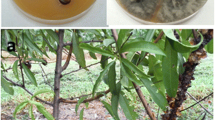Abstract
Lathyrus odoratus L. × Lathyrus belinensis L. hybrids were produced using L. belinensis as the pollen parent, with fertile seed produced by the L. odoratus parent. The F1 hybrid plants were completely self-sterile, but produced viable seeds when backcrossed to L. odoratus. The plants produced by backcrossing resembled L. odoratus, the flower colour being purple/magenta, and were self-fertile. Both hybrid plants and those produced by back crossing to L. odoratus were resistant to Erysiphe pisi DC that causes powdery mildew in sweet peas. Continued backcrossing resulted in hybrid plants, that closely resembled the L. odoratus parent, but segregated for complete resistance/susceptibility to E. pisi,with a ratio of 2.46:1 resistant to sensitive plants. This suggests the presence of a single dominant gene that confers resistance. When resistant and sensitive plants were inoculated with E. pisi and their leaf surfaces examined,using a Scanning Electron Microscope, it was found that although spores germinated on the leaves of both resistant and sensitive plants, spores present on resistant plants collapsed shortly after germination. Possible reasons for this are discussed.
Similar content being viewed by others
References
Butler, W.L. & M. Kitajima, 1975. Fluorescence quenching in photosystem II of chloroplasts. Biochim Biophys Acta 376: 116-125.
Carver, T.L.W. & S.W. Jones. 1988. Colony development by Erysiphe graminis f. sp. Hordei on isolated epidermis of barley coleoptile incubated under continuous light or short-day conditions. Trans Brit Mycol Soc 90: 114-116.
Chappelle, E.W., M.S. Kim & J.E. McMurtrey, 1992. Ratio analysis of reflectance spectra (RARS): an algorithum for remote estimation of the concentrations of chlorophyll a, chlorophyll b, and carotenoids in soybean. Rem Sen Environ 39: 239-247.
Crane, M.B. & W.J.C. Lawrence, 1947. The Genetics of Garden Plants. London, Macmillan Press.
Edwards, H.H., 2002. Development of primary germ tubes by conidia of Blumeria graminis f.sp hordei on leaf epidermal cells of Hordeum vulgare. Can J Bot 80: 1121-1125.
Genty, B., J.M. Briantais & N.R. Baker, 1989. The relationship between the quantum yield of photosynthetic electron transport and quenching of chlorophyll fluorescence. Biochim Biophys Acta 990: 87-92.
Hammett, K.R.W., B.G. Murray, K.R. Markham & I.C. Hallet, 1994. Interspecific hybridisation between Lathyrus odoratus and L. belinensis. Int J Plant Sci 155: 763-771.
Heath, M.C., 2000. Hypersensitive response-related death. Plant Mol Biol 44: 321-334.
Jorgensen, J.H., 1996. Effect of three suppressors on the expression of powdery mildew resistance genes in barley. Genome 39: 492-498.
Lenne, J.M. & D. Wood, 1991. Plant-diseases and the use of wild germplasm. Annu Rev Phytopathol 29: 35-63.
Minarcic P. & A. Janitor, 1995. Halo formation in the epidermalcell of barley after powdery mildew (Erysiphe graminis DC) infection. Biologia 50: 73-78.
Maxted, N. & D.J. Goyder, 1988. A new species of Lathyrus sect. Lathyrus (Leguminosae-Papilionoideae) from Turkey. Kew Bull 43: 711-714.
Sharma, T.R. & B.M. Singh, 1992. Transfer of resistance to Alternaria brassicae in Brassica juncea through interspecific hybridization among Brassicas. J Genet Breed 46: 373-378.
Singh, U.P., B. Prithiviraj & B.K. Sarma, 2000. Development of Erysiphe pisi (Powdery Mildew) on normal and albino mutants of pea (Pisum sativum L.). J Phytopathol 148: 591-595.
Stanhill, G., 1981. The size and significance of differences in the radiation balance of plants and plant communities. In: G. Grace, E.D. Ford & P.G. Jarvis (Eds.), Plants and Their Atmospheric Environment. 21st Symposium of the British Ecological Society. Blackwell Scientific Publishers, Oxford.
Schulze-Lefert, P. & J. Vogel, 2000. Closing the ranks to attack by powdery mildew. Trends in Plant Sci 5: 343-348.
Talbot, N.J. & L. Hamer, 2000. Taming the uncultured. Nature 18: 146-147.
Vanacker, H., T.L.W. Carver & C.H. Foyer, 1998. Changes in apoplastic antioxidants induced by powdery mildew attack in oat genotypes with race non-specific resistance. Planta 208: 444-452.
Vilijanen-Rollinson, S.L.H., R.E. Gaunt, C.M.A. Frampton, R.E. Fallon & D.L. McNeil, 1998. Components of quantitative resistance to powdery mildew (Erysiphe pisi) in pea (Pisum sativum). Plant Path 47: 137-147.
Wharton, D.A. & D.S. Murray, 1990. Preparation of the nematode-trapping fungus, Arthrobotrys oligospora, for scanning electron microscopy by freeze substitution. J Microsc 158: 81-85.
Zhang, L.T., R.A. Pickering & B.G. Murray, 2001. Hordeum vulgare × H. bulbosum tetraploid hybrid provides useful agronomic introgression lines for breeders. NZ J Crop Hort Sci 29: 239-246.
Author information
Authors and Affiliations
Rights and permissions
About this article
Cite this article
Poulter, R., Harvey, L. & Burritt, D.J. Qualitative resistance to powdery mildew in hybrid sweet peas. Euphytica 133, 349–358 (2003). https://doi.org/10.1023/A:1025734428660
Issue Date:
DOI: https://doi.org/10.1023/A:1025734428660



